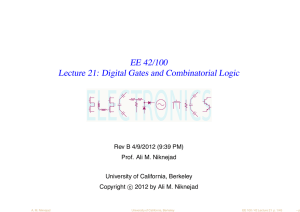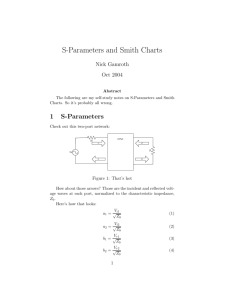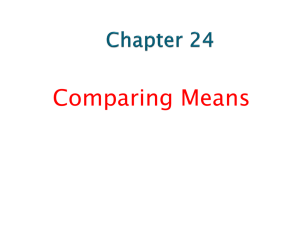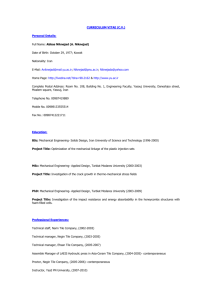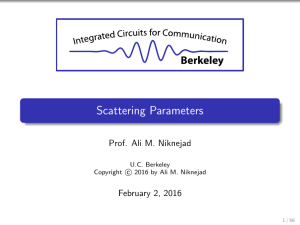Document 11094757
advertisement
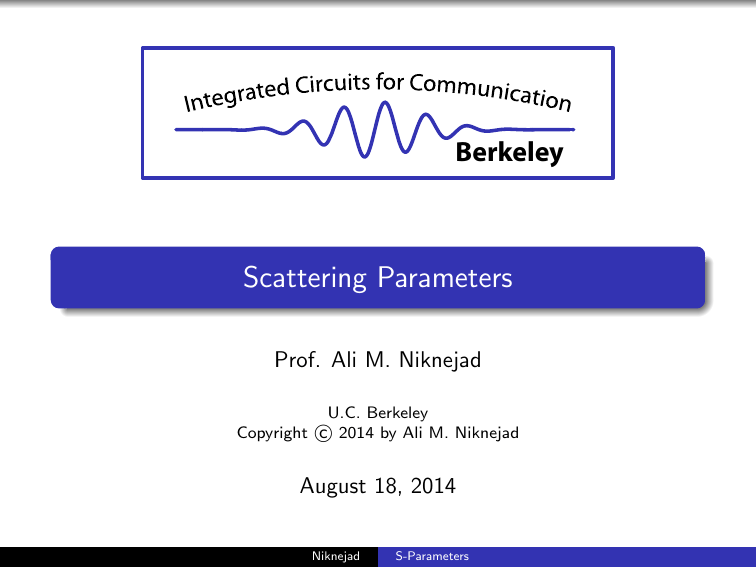
Berkeley
Scattering Parameters
Prof. Ali M. Niknejad
U.C. Berkeley
c 2014 by Ali M. Niknejad
Copyright August 18, 2014
Niknejad
S-Parameters
Scattering Parameters
Niknejad
S-Parameters
Scattering Matrix
Voltages and currents are difficult to measure directly at
microwave freq. Z matrix requires “opens”, and it’s hard to
create an ideal open (parasitic capacitance and radiation).
Likewise, a Y matrix requires “shorts”, again ideal shorts are
impossible at high frequency due to the finite inductance.
Many active devices could oscillate under the open or short
termination.
S parameters are easier to measure at high frequency. The
measurement is direct and only involves measurement of
relative quantities (such as the SWR or the location of the
first minima relative to the load).
Niknejad
S-Parameters
S-Parameters
V1+
1
V1−
3
V2−
V3−
V3+
2
V2+
Scattering parameters represent the flow of power into and
out of ports of an arbitrary N-port
It’s important to realize that although we associate S
parameters with high frequency and wave propagation, the
concept is valid for any frequency.
Niknejad
S-Parameters
Power Flow in an One-Port
We begin with the simple observation that the power flow into
a one-port circuit can be written in the following form
Pin = Pavs − Pr
where Pavs is the available power from the source. Unless
otherwise stated, let us assume sinusoidal steady-state. If the
source has a real resistance of Z0 , this is simply given by
Pavs =
Vs2
8Z0
Of course if the one-port is conjugately matched to the source,
then it will draw the maximal available power from the source.
Otherwise, the power Pin is always less than Pavs , which is
reflected in our equation. In general, Pr represents the wasted
or untapped power that one-port circuit is “reflecting” back to
the source due to a mismatch. For passive circuits it’s clear
that each term in the equation is positive and Pin ≥ 0.
Niknejad
S-Parameters
Power Absorbed by One-Port
The complex power absorbed by the one-port is given by
1
Pin = (V1 · I1∗ + V1∗ · I1 )
2
which allows us to write
Pr = Pavs − Pin =
1
Vs2
− (V1 I1∗ + V1∗ I1 )
4Z0 2
the factor of 4 instead of 8 is used since we are now dealing
with complex power. The average power can be obtained by
taking one half of the real component of the complex power.
If the one-port has an input impedance of Zin , then the power
Pin is expanded to
Zin∗
1
Vs
Zin
Vs∗
∗
Pin =
Vs ·
+
V ·
2 Zin + Z0
(Zin + Z0 )∗ (Zin + Z0 )∗ s (Zin + Z0 )
Niknejad
S-Parameters
(cont.)
The previous equation is easily simplified to (where we have
assumed Z0 is real)
|Vs |2 Z0 Zin + Zin∗ Z0
Pin =
2Z0
|Zin + Z0 |2
With the exception of a factor of 2, the premultiplier is simply
the source available power, which means that our overall
expression for the reflected power is given by
Z0 Zin + Zin∗ Z0
Vs2
1−2
Pr =
4Z0
|Zin + Z0 |2
which can be simplified
Zin − Z0 2
= Pavs |Γ|2
Pr = Pavs Zin + Z0 Niknejad
S-Parameters
Definition of Reflection Coefficient
Zin − Z0 2
= Pavs |Γ|2
Pr = Pavs Zin + Z0 We have defined Γ, or the reflection coefficient, as
Γ=
Zin − Z0
Zin + Z0
From the definition it is clear that |Γ| ≤ 1, which is just a
re-statement of the conservation of energy implied by our
assumption of a passive load.
This constant Γ, also called the scattering parameter of a
one-port, plays a very important role. On one hand we see
that it is has a one-to-one relationship with Zin .
Niknejad
S-Parameters
Scattering Parameter
Given Γ we can solve for Zin by inverting the above equation
Zin = Z0
1+Γ
1−Γ
which means that all of the information in Zin is also in Γ.
Moreover, since |Γ| < 1, we see that the space of the
semi-infinite space of all impedance values with real positive
components (the right-half plane) maps into the unit circle.
This is a great compression of information which allows us to
visualize the entire space of realizable impedance values by
simply observing the unit circle. We shall find wide
application for this concept when finding the appropriate
load/source impedance for an amplifier to meet a given noise
or gain specification.
Niknejad
S-Parameters
Scattering Parameter as Power Flow
More importantly, Γ expresses very direct and obviously the
power flow in the circuit. If Γ = 0, then the one-port is
absorbing all the possible power available from the source. If
|Γ| = 1 then the one-port is not absorbing any power, but
rather “reflecting” the power back to the source. Clearly an
open circuit, short circuit, or a reactive load cannot absorb net
power. For an open and short load, this is obvious from the
definition of Γ. For a reactive load, this is pretty clear if we
substitute Zin = jX
q
X2 + Z2
jX − Z0 0
= q
=1
|ΓX | = jX + Z0
2
2
X + Z0 Niknejad
S-Parameters
Relation between Z and Γ
The transformation between impedance and Γ is the well
known Bilinear Transform. It is a conformal mapping
(meaning that it preserves angles) from vertical and horizontal
lines into circles. We have already seen that the jX axis is
mapped onto the unit circle.
Since |Γ|2 represents power flow, we may imagine that Γ
should represent the flow of voltage, current, or some linear
combination thereof. Consider taking the square root of the
basic equation we have derived
p
p
Pr = Γ Pavs
where we have retained the positive root. We may write the
above equation as
b1 = Γa1
where a and b have the units of square root of power and
represent signal flow in the network. How are a and b related
to currents and voltage?
Niknejad
S-Parameters
Definition of a and b
Let
a1 =
V1 + Z0 I1
√
2 Z0
b1 =
V1 − Z0 I1
√
2 Z0
and
It is now easy to show that for the one-port circuit, these
relations indeed represent the available and reflected power:
|a1 |2 =
|V1 |2 Z0 |I1 |2 V1∗ · I1 + V1 · I1∗
+
+
4Z0
4
4
Now substitute V1 = Zin Vs /(Zin + Z0 ) and I1 = Vs /(Zin + Z0 )
we have
|a1 |2 =
Z0 |Vs |2
|Vs |2 Zin∗ Z0 + Zin Z0
|Vs |2 |Zin |2
+
+
4Z0 |Zin + Z0 |2 4|Zin + Z0 |2
4Z0 |Zin + Z0 |2
Niknejad
S-Parameters
a/b and Power Flow
We have now shown that a1 is associated with the power
available from the source:
|Vs |2 |Zin |2 + Z02 + Zin∗ Z0 + Zin Z0
2
|a1 | =
4Z0
|Zin + Z0 |2
|Vs |2 |Zin + Z0 |2
=
= Pavs
4Z0 |Zin + Z0 |2
In a like manner, the square of b is given by many similar
terms
|Vs |2 |Zin |2 + Z02 − Zin∗ Z0 − Zin Z0
2
|b1 | =
=
4Z0
|Zin + Z0 |2
|Zin − Z0 2
= Pavs |Γ|2
Pavs Zin + Z0 as expected.
= |a1 |2 |Γ|2
Niknejad
S-Parameters
One-Port Equation
We can now see that the expression b = Γ · a is analogous to
the expression V = Z · I or I = Y · V and so it can be
generalized to an N-port circuit. In fact, since a and b are
linear combinations of v and i, there is a one-to-one
relationship between the two. Taking the sum and difference
of a and b we arrive at
V1
2V1
a1 + b1 = √ = √
2 Z0
Z0
which is related to the port voltage and
p
2Z0 I1
a1 − b1 = √ = Z0 I1
2 Z0
which is related to the port current.
Niknejad
S-Parameters
Incident and Scattered Waves
Niknejad
S-Parameters
Incident and Scattered Waves
Let’s define the vector v + as the incident “forward” waves on
each transmission line connected to the N port. Define the
reference plane as the point where the transmission line
terminates onto the N port.
The vector v − is then the reflected or “scattered” waveform
at the location
of theport.
−
V1+
V1
V +
V −
2
2
v − = V −
v + = V +
3
3
..
..
.
.
Niknejad
S-Parameters
Scattering Waves (cont)
Because the N port is linear, we expect that scattered field to
be a linear function of the incident field
v − = Sv +
S is the scattering matrix
S11 S12 · · ·
..
.
S =
S21
..
.
Niknejad
S-Parameters
Relation to Voltages
The fact that the S matrix exists can be easily proved if we
recall that the voltage and current on each transmission line
termination can be written as
Vi = Vi+ + Vi−
Ii = Y0 (Ii+ − Ii− )
Inverting these equations
Vi + Z0 Ii = Vi+ + Vi− + Vi+ − Vi− = 2Vi+
Vi − Z0 Ii = Vi+ + Vi− − Vi+ + Vi− = 2Vi−
Thus v + ,v − are simply linear combinations of the port
voltages and currents. By the uniqueness theorem, then,
v − = Sv + .
Niknejad
S-Parameters
Measure Sij
1
Z0
2
Z0
3
V1+
V1−
V2−
4
Z0
5
Z0
6
Z0
The term Sij can be computed
directly by the following formula
Vi− Sij = + Vj +
V3−
Vk =0 ∀ k6=j
In other words, to measure Sij , drive port j with a wave
amplitude of Vj+ and terminate all other ports with the
characteristic impedance of the lines (so that Vk+ = 0 for
k 6= j). Then observe the wave amplitude coming out of the
port i
Niknejad
S-Parameters
S Matrix for a 1-Port Capacitor
Let’s calculate the S parameter for
a capacitor
Z0
C
S11 =
V1−
V1+
This is of course just the reflection coefficient for a capacitor
S11
ZC − Z0
= ρL =
=
ZC + Z0
=
Niknejad
1 − jωCZ0
1 + jωCZ0
S-Parameters
1
jωC
1
jωC
− Z0
+ Z0
S Matrix for a 1-Port Cap
Z0
Let’s calculate the S parameter for
a capacitor directly from the
definition of S parameters
C
S11 =
V1−
V1+
Substituting for the current in a capacitor
V1− = V − IZ0 = V − jωCV = V (1 − jωCZ0 )
V1+ = V + IZ0 = V + jωCV = V (1 + jωCZ0 )
We arrive at the same answer as expected
=
Niknejad
1 − jωCZ0
1 + jωCZ0
S-Parameters
S Matrix for a 2-Port Shunt Element
Consider a shunt impedance connected at the junction of two
transmission lines. The voltage at the junction is of course
continuous. The currents, though, differ
V1 = V2
Z0
ZL
Z0
I1 + I2 = YL V2
To compute S11 , enforce V2+ = 0 by terminating the line.
Thus we can be re-write the above equations
V1+ + V1− = V2−
Y0 (V1+ − V1− ) = Y0 V2− + YL V2− = (YL + Y0 )V2−
Niknejad
S-Parameters
Shunt Element (cont)
We can now solve the above eq. for the reflected and
transmitted wave
V1− = V2− − V1+ =
Y0
(V + − V1− ) − V1+
YL + Y0 1
V1− (YL + Y0 + Y0 ) = (Y0 − (Y0 + YL ))V1+
S11 =
V1−
Z0 ||ZL − Z0
Y0 − (Y0 + YL )
+ = Y + (Y + Y ) = Z ||Z + Z
V1
0
0
0
0
L
L
The above eq. can be written by inspection since Z0 ||ZL is the
effective load seen at the junction of port 1.
Thus for port 2 we can write
S22 =
Niknejad
Z0 ||ZL − Z0
Z0 ||ZL + Z0
S-Parameters
Shunt Element (cont)
Likewise, we can solve for the transmitted wave, or the wave
scattered into port 2
V−
S21 = 2+
V1
Since V2− = V1+ + V1− , we have
S21 = 1 + S11 =
2Z0 ||ZL
Z0 ||ZL + Z0
By symmetry, we can deduce S12 as
S12 =
Niknejad
2Z0 ||ZL
Z0 ||ZL + Z0
S-Parameters
Conversion Formula
Since V + and V − are related to V and I , it’s easy to find a
formula to convert for Z or Y to S
Vi = Vi+ + Vi− → v = v + + v −
Zi0 Ii = Vi+ − Vi− → Z0 i = v + − v −
Now starting with v = Zi, we have
v + + v − = ZZ0−1 (v + − v − )
Note that Z0 is the scalar port impedance
v − (I + ZZ0−1 ) = (ZZ0−1 − I )v +
v − = (I + ZZ0−1 )−1 (ZZ0−1 − I )v + = Sv +
Niknejad
S-Parameters
Conversion (cont)
We now have a formula relating the Z matrix to the S matrix
S = (ZZ0−1 + I )−1 (ZZ0−1 − I ) = (Z + Z0 I )−1 (Z − Z0 I )
Recall that the reflection coefficient for a load is given by the
same equation!
Z /Z0 − 1
ρ=
Z /Z0 + 1
To solve for Z in terms of S, simply invert the relation
Z0−1 ZS + IS = Z0−1 Z − I
Z0−1 Z (I − S) = S + I
Z = Z0 (I + S)(I − S)−1
As expected, these equations degenerate into the correct form
1+S11
for a 1 × 1 system Z11 = Z0 1−S
11
Niknejad
S-Parameters
Properties of S-Parameters
Niknejad
S-Parameters
Shift in Reference Planes
Note that if we move the reference planes, we can easily
recalculate the S parameters.
We’ll derive a new matrix S 0 related to S. Let’s call the waves
at the new reference ν
v − = Sv +
ν − = S 0ν +
Since the waves on the lossless transmission lines only
experience a phase shift, we have a phase shift of θi = βi `i
νi− = v − e −jθi
νi+ = v + e jθi
Niknejad
S-Parameters
Reference Plane (cont)
Or we have
jθ
e 1
0
···
0 e jθ2 · · ·
0
0 e jθ3
..
.
−jθ
e 1
0
−
ν =S 0
· · ·
..
.
0
e −jθ2
0
···
···
e −jθ3
So we see that the new S matrix is simply
−jθ
−jθ
e 1
0
···
e 1
0
−jθ
−jθ2
0
0
2
e
·
·
·
e
S0 = 0
−jθ3 · · · S 0
0
e
0
..
..
.
.
Niknejad
S-Parameters
+
ν
· · ·
···
···
e −jθ3
· · ·
Normalized S-Parameters
a1
b1
[S]
b2
a2
Let’s introduce normalized voltage waves
v + (x)
v − (x)
a(x) = √
b(x) = √
Z0
Z0
2
2
So now |a| and |b| represent the power of the forward and
reverse wave. Define the scattering matrix as before
b = Sa
For a 2 × 2 system, this is simply
b1
S11 S12 a1
=
b2
S21 S22 a2
Niknejad
S-Parameters
Generalized Scattering Parameters
We can use different impedances Z0,n at each port and so we
have the generalized incident and reflected waves
v+
v−
an = p n
bn = p n
Z0,n
Z0,n
The scattering parameters are now given by
p
bi Vi− Z0,j Sij = Sij = + p
aj ak6=j =0
Vj
Z0,i +
Vk6=j =0
Consider the current and voltage in terms of a and b
p
Vn = vn+ + vn− = Z0,n (an + bn )
1
1
In =
(an − bn )
vn− − vn− = p
Z0,n
Z0,n
The power flowing into this port is given by
1
1
1
< (Vn In∗ ) = < |an |2 − |bn |2 + (bn an∗ − bn∗ an ) =
|an |2 − |bn |2
2
2
2
Niknejad
S-Parameters
Scattering Transfer Parameters
b2
a1
b1
a3
[T]
[T]
a2
b4
a4
b3
Up to now we found it convenient to represent the scattered
waves in terms of the incident waves. But what if we wish to
cascade two ports as shown?
Since b2 flows into a10 , and likewise b10 flows into a2 , would it
not be convenient if we defined the a relationship between
a1 ,b1 and b2 ,a2 ?
In other words we have
a1
T11 T12 b2
=
b1
T21 T22 a2
Notice carefully the order of waves (a,b) in reference to the
figure above. This allows us to cascade matrices
a1
b
a
b
= T1 2 = T1 3 = T1 T2 4
b1
a2
b3
a4
Niknejad
S-Parameters
Reciprocal Networks
Niknejad
S-Parameters
Reciprocal Networks
Suppose the Z /Y matrix are symmetric. Now let’s see what
we can infer about the S matrix.
1
v + = (v + Z0 i)
2
1
v − = (v − Z0 i)
2
Substitute v = Zi in the above equations
1
1
v + = (Zi + Z0 i) = (Z + Z0 )i
2
2
1
1
v − = (Zi − Z0 i) = (Z − Z0 )i
2
2
Since i = i, the above eq. must result in consistent values of
i. Or
2(Z + Z0 )−1 v + = 2(Z − Z0 )−1 v −
Niknejad
S-Parameters
Reciprocal Networks (cont)
From the above, we have
S = (Z − Z0 )(Z + Z0 )−1
Consider the transpose of the S matrix
t
S t = (Z + Z0 )−1 (Z − Z0 )t
Recall that Z0 is a diagonal matrix
S t = (Z t + Z0 )−1 (Z t − Z0 )
If Z t = Z (reciprocal network), then we have
S t = (Z + Z0 )−1 (Z − Z0 )
Niknejad
S-Parameters
(cont)
Previously we found that
S = (Z + Z0 )−1 (Z − Z0 )
So that we see that the S matrix is also symmetric (under
reciprocity)S t = S
Note that in effect we have shown that
(Z + I )−1 (Z − I ) = (Z − I )(Z + I )−1
This is easy to demonstrate if we note that
Z 2 − I = Z 2 − I 2 = (Z + I )(Z − I ) = (Z − I )(Z + I )
In general matrix multiplication does not commute, but here
it does
(Z − I ) = (Z + I )(Z − I )(Z + I )−1
(Z + I )−1 (Z − I ) = (Z − I )(Z + I )−1
Thus we see that S t = S.
Niknejad
S-Parameters
S-Parameters of a Lossless Network
Consider the total power dissipated by a network (must sum
to zero)
1
Pav = < v t i ∗ = 0
2
Expanding in terms of the wave amplitudes
1
= < (v + + v − )t Z0−1 (v + − v − )∗
2
Where we assume that Z0 are real numbers and equal. The
notation is about to get ugly
=
1
t
∗
t
∗
t
∗
t
∗
< v+ v+ − v+ v− + v− v+ − v− v−
2Z0
Niknejad
S-Parameters
Lossless (cont)
Notice that the middle terms sum to a purely imaginary
number. Let x = v + and y = v −
y t x ∗ − x t y ∗ = y1 x1∗ + y2 x2∗ + · · · − x1 y1∗ + x2 y2∗ + · · · = a − a∗
We have shown that
1
t
Pav =
v| +{zv +}
2Z0
total incident power
Niknejad
−
t
∗
v| −{zv −}
=0
total reflected power
S-Parameters
(cont)
This is a rather obvious result. It simply says that the incident
power is equal to the reflected power (because the N port is
lossless). Since v − = Sv +
t
t
v + v + = (Sv + )t (Sv + )∗ = v + S t S ∗ v +
This can only be true if S is a unitary matrix
StS∗ = I
S ∗ = (S t )−1
Niknejad
S-Parameters
∗
Orthogonal Properties of S
Expanding out the matrix product
X
X
δij =
(S T )ik Skj∗ =
Ski Skj∗
k
k
For i = j we have
X
Ski Ski∗ = 1
k
For i 6= j we have
X
Ski Skj∗ = 0
k
The dot product of any column of S with the conjugate of
that column is unity while the dot product of any column with
the conjugate of a different column is zero. If the network is
reciprocal, then S t = S and the same applies to the rows of S.
Note also that |Sij | ≤ 1.
Niknejad
S-Parameters
S-Parameter Representation of a Source
Niknejad
S-Parameters
Representation of Source
ZS IS
+
VS
Vi
−
Vi = Vs − Is Zs
The voltage source can be represented directly for s-parameter
analysis as follows. First note that
+
Vi−
Vi
+
−
Vi + Vi = Vs +
−
Zs
Z0
Z0
Solve these equations for Vi− , the power flowing away from
the source
Zs − Z0
Z0
Vi− = Vi+
+
Vs
Zs + Z0 Z0 + Zs
√
Dividing each term by Z0 , we have
√
Vi−
Vi+
Z0
√ = √ Γs +
Vs
Z
+
Zs
Z0
Z0
0
Niknejad
bi = ai Γs + bs bs = Vs
S-Parameters
p
Z0 /(Z0 +Zs )
Available Power from Source
A useful quantity is the available power from a source under
conjugate matched conditions. Since
Pavs = |bi |2 − |ai |2
If we let ΓL = Γ∗S , then using ai = ΓL bi , we have
bi = bs + ai ΓS = bs + Γ∗S bi ΓS
Solving for bi we have
bi =
bs
1 − |ΓS |2
So the Pavs is given by
Pavs = |bi |2 − |ai |2 = |bs |2
=
|bs |2
1 − |ΓS |2
Niknejad
1 − |ΓS |2
(1 − |ΓS |2 )2
S-Parameters
Signal Flow Analysis
Niknejad
S-Parameters
Signal-Flow Analysis
S21
a1
b2
S22
S11
b1
S12
a2
Each signal a and b in the system is represented by a node.
Branches connect nodes with “strength” given by the
scattering parameter. For example, a general two-port is
represented above.
Using three simple rules, we can simplify signal flow graphs to
the point that detailed calculations are done by inspection. Of
course we can always “do the math” using algebra, so pick
the technique that you like best.
Niknejad
S-Parameters
Series and Parallel Rules
SB
SA
a1
a2
SA SB
a1
a3
a3
Rule 1: (series rule) By inspection, we have the cascade.
SA
a1
SA + SB
a2
a1
SB
Rule 2: (parallel rule) Clear by inspection.
Niknejad
S-Parameters
a2
Self-Loop Rule
SB
SC
SA
a1
a2
a3
SA
1 − SB
a1
SC
a2
a3
Rule 3: (self-loop rule) We can remove a “self-loop” by
multiplying branches feeding the node by 1/(1 − SB ) since
a2 = SA a1 + SB a2
a2 (1 − SB ) = SA a1
a2 =
Niknejad
SA
a1
1 − SB
S-Parameters
Splitting Rule
SB
a2
a1
SA
a1
a2
a3
SA
SC
SB
SA
a4
a!2
SC
a3
a4
We can duplicate node a2 by splitting the signals at an earlier
phase
Niknejad
S-Parameters
Example: Signal Flow Analysis
S22 ΓL
a1
S21
b2
a1
S22
S11
S21
ΓL
b2
ΓL
S11
b1
S12
a2
b1
S12
a2
Using the above rules, we can calculate the input reflection
coefficient of a two-port terminated by ΓL = b1 /a1 using a
couple of steps.
First we notice that there is a self-loop around b2 .
a1
S21
1 − S22 ΓL
b2
ΓL
S11
b1
S12
a2
Next we remove the self loop and from here it’s clear that the
b1
S21 S12 ΓL
Γin =
= S11 +
a1
1 − S22 ΓL
Niknejad
S-Parameters
Mason’s Rule
bS
P1
S21
a1
ΓS
S22
S11
b1
b2
S12
P2
ΓL
a2
Using Mason’s Rule, you can calculate the transfer function
for a signal flow graph by “inspection”
P
P
P
P1 1 − L(1)(1) + L(2)(1) − · · · + P2 1 − L(1)(2) + ·
P
P
P
T =
1 − L(1) + L(2) − L(3) + · · ·
Each Pi defines a path, a directed route from the input to the
output not containing each node more than once. The value
of Pi is the product of the branch coefficients along the path.
For instance the path from bs to b1 (T = b1 /bs ) has two
paths, P1 = S11 and P2 = S21 ΓL S12
Niknejad
S-Parameters
Loop of Order Summation Notation
bS
S21
a1
ΓS
S22
S11
b1
b2
S12
ΓL
P
The notation
L(1) is
the sum over all first order
loops.
a2
A “first order loop” is defined as product of the branch values
in a loop in the graph. For the given example we have Γs S11 ,
S22 ΓL , and Γs S21 ΓL S12 .
A “second order loop” L(2) is the product of two
non-touching first-order loops. For instance, since loops S11 Γs
and S22 ΓL do not touch, their product is a second order loop.
A “third order loop” L(3) is likewise the product of three
non-touching first order loops.
P
The notation
L(1)(p) is the sum of all first-order loops that
do
the path p. For path P1 , we have
P not touch
P
L(1)(1) = ΓL S22 but for path P2 we have
L(1)(2) = 0.
Niknejad
S-Parameters
Example: Input Reflection of Two-Port
a1
S21
b2
S22
S11
b1
S12
ΓL
a2
Using Mason’s rule, you can quickly identify the relevant
paths for a Γin = b1 /a1 .
There are two paths P1 = S11 and P2 = S21 ΓL S12
P
There is only one first-order loop:
L(1) = S22 ΓL and so
naturally there are no higher order loops.
Note that the loop does not touch path P1 , so
P
L(1)(1) = S22 ΓL .
Now let’s apply Mason’s general formula
Γin =
S11 (1 − S22 ΓL ) + S21 ΓL S12
S21 ΓL S12
= S11 +
1 − S22 ΓL
1 − S22 ΓL
Niknejad
S-Parameters
Example: Transducer Power Gain
bS
S21
a1
ΓS
S22
S11
b1
b2
S12
ΓL
a2
By definition, the transducer power gain is given by
PL
|b2 |2 (1 − |ΓL |2 ) b2 2
GT =
=
= (1 − |ΓL |2 )(1 − |ΓS |2 )
|bs |2
PAVS
bS
2
1−|ΓS |
By Mason’s Rule, there is only one path P1 = S21 from bS to
b2 so we have
X
L(1) = ΓS S11 + S22 ΓL + ΓS S21 ΓL S12
X
X
L(2) = ΓS S11 ΓL S22
Niknejad
S-Parameters
L(1)(1) = 0
Transducer Gain (cont)
The gain expression is thus given by
b2
S21 (1 − 0)
=
bS
1 − ΓS S11 − S22 ΓL − ΓS S21 ΓL S12 + ΓS S11 ΓL S22
The denominator is in the form of 1 − x − y + xy which allows
us to write
GT =
|S21 |2 (1 − |ΓS |2 )(1 − |ΓL |2 )
|(1 − S11 ΓS )(1 − S22 ΓL ) − S21 S12 ΓL ΓS |2
Recall that Γin = S11 + S21 S12 ΓL /(1 − S22 ΓL ). Factoring out
1 − S22 ΓL from the denominator we have
S21 S12 ΓL
den = 1 − S11 ΓS −
ΓS (1 − S22 ΓL )
1 − S22 ΓL
S21 S12 ΓL
den = 1 − ΓS S11 +
(1 − S22 ΓL )
1 − S22 ΓL
= (1 − ΓS Γin )(1 − S22 ΓL )
Niknejad
S-Parameters
Transducer Gain Expression
This simplifications allows us to write the transducer gain in
the following convenient form
GT =
2
1 − |ΓS |2
2 1 − |ΓL |
|S
|
21
|1 − Γin ΓS |2
|1 − S22 ΓL |2
Which can be viewed as a product of the action of the input
match “gain”, the intrinsic two-port gain |S21 |2 , and the
output match “gain”. Since the general two-port is not
unilateral, the input match is a function of the load.
Likewise, by symmetry we can also factor the expression to
obtain
2
1 − |ΓS |2
2 1 − |ΓL |
GT =
|S
|
21
|1 − S11 ΓS |2
|1 − Γout ΓL |2
Niknejad
S-Parameters
Refs
“S Parameter Design,” Hewlett-Packard Application Note
154, April 1972.
Microwave Transistor Amplifiers, Analysis and Design,
Guillermo Gonzalez, Prentice Hall 1984.
Microwave Engineering, David Pozer, Third Edition, Wiley
2005.
Microwave Circuit Design Using Linear and Nonlinear
Techniques, by George Vendelin, Anthony M. Pavio, & Ulrich
L. Rohde, Wiley 1995.
Niknejad
S-Parameters
